We are no longer building saddle trees, but we have two videos about how Western saddles fit horses available on our westernsaddlefit.com website.
The Proper Position of a Western saddle
The first of the 3 Ps in our Principles of saddle fit is Position. The shape of the tree is designed to match the shape of the horse's back when it is sitting in the proper place. If the saddle is sitting in another position on the back, the shapes will no longer match. If the shapes don't match, you will have high pressure spots (Poking - Principle #2) and places where there is no contact to help distribute the Pressure (Principle #3). This means that most of what the saddle and tree makers do to ensure proper fit for the horse is thrown out the window when the rider places and holds the saddle in the wrong position. (For those of you who prefer videos to reading, here is a comprehensive video about the proper position. And here is the quick and easy version.)
So where is the proper place?
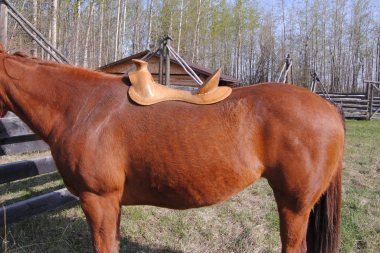 A western saddle tree is designed to fit right behind the shoulder blades of the horse in what is often called the “wither pocket” area. To a lot of people, this appears to be too far back, but that is only because they are used to seeing malpositioned saddles. Unfortunately, positioning the saddle according to rigging position so the cinch hangs vertical fairly close behind the elbow is a very common practice. This often puts the saddle too far forward with the bar on the shoulder blade itself, but since it "looks right" to people used to seeing saddles positioned that way, they tighten the breast collar to hold it in what they think is the "right place" - and in doing so harm their horse.
A western saddle tree is designed to fit right behind the shoulder blades of the horse in what is often called the “wither pocket” area. To a lot of people, this appears to be too far back, but that is only because they are used to seeing malpositioned saddles. Unfortunately, positioning the saddle according to rigging position so the cinch hangs vertical fairly close behind the elbow is a very common practice. This often puts the saddle too far forward with the bar on the shoulder blade itself, but since it "looks right" to people used to seeing saddles positioned that way, they tighten the breast collar to hold it in what they think is the "right place" - and in doing so harm their horse.
What happens if you put it in the wrong spot?
While it is ideal to place the saddle in the correct spot right at the beginning, do you have to be worried if the saddle is an inch or two forward or back of the ideal? Not if you just put it there, cinch up and ride. Because, just like matching teaspoons which always slide into place where the shapes match best, a tree will move to where it is supposed to be - where the shapes match - within a few minutes. That is, unless it is put so far out of position there is no reason for it to move there, or if it is held out of place by a breast collar, crupper or britching. When that happens (and it is very, very common) real damage occurs to the horse. However, if there is no place the shapes match very well because the saddle really doesn't fit the horse at all, then it won't move to the correct spot, but it will likely move around a lot.
What happens if it is held too far forward?
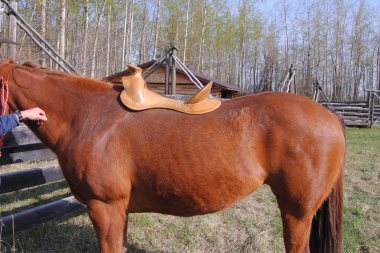 Firstly, the tree is sitting on the shoulder blade, compressing the muscles that lie over the shoulder blade between bar and bone. This causes damage and in the long run results in atrophy of these muscles, making hollows behind shoulder blades that appear to stick out too far from the body.
Firstly, the tree is sitting on the shoulder blade, compressing the muscles that lie over the shoulder blade between bar and bone. This causes damage and in the long run results in atrophy of these muscles, making hollows behind shoulder blades that appear to stick out too far from the body.
Secondly, it causes bridging, with weight being carried on the front bar pads and the back of the bar but minimal to no contact under the middle of the tree. This means the Pressure is not distributed over the whole tree, causing higher Pressures where there is contact.
Thirdly, it tilts the tree backwards. This often causes the back bar tips to Poke - dig into the horse - especially if they are shorter bars with less rock. If a horse is sore farther back, it is good to watch the rider saddle their horse to see where it is positioned, then check where those back bar tips line up. Often, it is right over where the horse is sore. This has serious effects not only on muscle health, but how the horse moves and his overall performance.
Fourthly, tilting the tree backwards also affects how the rider will sit in the seat. They are forced to put more weight toward the back of the bars, making the problem of the back bar tips digging into the horse worse. They may also have problems getting their feet under them, depending on how the groundseat is shaped, because they are sitting farther back in the saddle.
What if it is placed too far back?
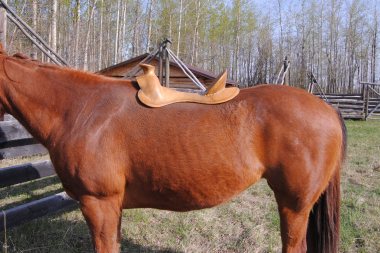 Unless it is held back with a crupper or britching, even a tree that doesn't fit well will move forward right away. However, if it is held too far back, that position may cause the tree to tilt forward on the horse. This will bring the gullet closer to the top of the withers, perhaps making contact if it was close already. It also means that the rider's weight is carried more on the front of the tree, increasing the Pressure there and possibly causing Poking by the front bar tips. Depending on how the groundseat is shaped, it may also make the rider feel like they are falling forward on the horse and/or that their feet are too far behind them.
Unless it is held back with a crupper or britching, even a tree that doesn't fit well will move forward right away. However, if it is held too far back, that position may cause the tree to tilt forward on the horse. This will bring the gullet closer to the top of the withers, perhaps making contact if it was close already. It also means that the rider's weight is carried more on the front of the tree, increasing the Pressure there and possibly causing Poking by the front bar tips. Depending on how the groundseat is shaped, it may also make the rider feel like they are falling forward on the horse and/or that their feet are too far behind them.
What about shoulder movement?
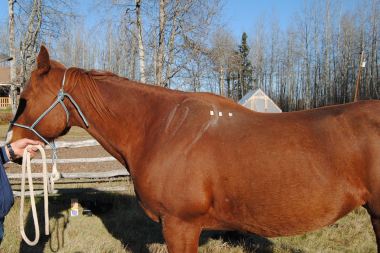 The shoulder blades do rotate back when the horse moves. The three pieces of tape in the picture above show the farthest forward movement, the standing position and the farthest back movement at a walk. So why isn't the muscle over the shoulder compressed between the shoulder blade and the front bar tips at maximum rotation if the bar is right behind the shoulder blade when the horse is standing? Because of two factors: 1.) The shoulder blade rotates back when the horse is moving his leg forward and there is no weight on it. 2.) There is no bony attachment between the front leg of the horse and his body. It is only held in place by muscle, and is therefore quite moveable, in and out as well as front, back and rotation. So as the shoulder blade rotates back, it can slide under the front bar tips of the tree because it is not held out from the body by bone (like human shoulders are). Because there is no weight on it, there is no high pressure to compress the muscle, and no pain or damage occurs. By the time there is weight on the leg, the shoulder blade is more upright, and therefore out from underneath the bar tip again.
The shoulder blades do rotate back when the horse moves. The three pieces of tape in the picture above show the farthest forward movement, the standing position and the farthest back movement at a walk. So why isn't the muscle over the shoulder compressed between the shoulder blade and the front bar tips at maximum rotation if the bar is right behind the shoulder blade when the horse is standing? Because of two factors: 1.) The shoulder blade rotates back when the horse is moving his leg forward and there is no weight on it. 2.) There is no bony attachment between the front leg of the horse and his body. It is only held in place by muscle, and is therefore quite moveable, in and out as well as front, back and rotation. So as the shoulder blade rotates back, it can slide under the front bar tips of the tree because it is not held out from the body by bone (like human shoulders are). Because there is no weight on it, there is no high pressure to compress the muscle, and no pain or damage occurs. By the time there is weight on the leg, the shoulder blade is more upright, and therefore out from underneath the bar tip again.
Shape is important
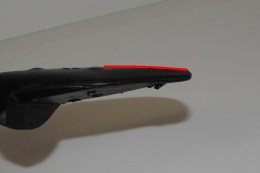 |
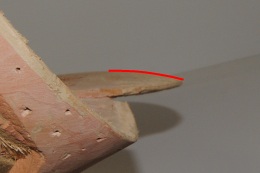 |
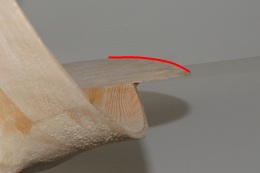 |
| No relief on bar tip of a "flexible" bar | Small amount of relief on bar tip | Relief on our front bar tip |
This assumes that the front bar tip is shaped with enough rounding/relief to assist the shoulder blade to slide underneath. Bars that are fairly straight going forward or that have blocky, blunt front bar tips will not work this way. The shoulder blade will bang into a "wall" of bar tip and have a high pressure point there. As discussed below, unblocked skirts can have the same effect.
Matching bar shape to horse shape
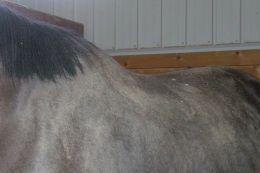 |
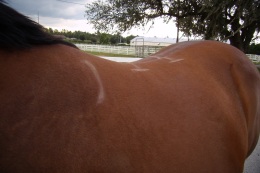 |
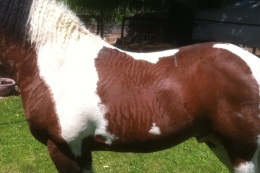 |
| Concave wither pocket area | Flat wither pocket area | Bulging wither pocket area |
Some horses are quite concave in the wither pocket. This can be due to their natural shape, undeveloped muscle or atrophied (shrunken) muscle from previous (usually saddle induced) damage. Others are flat and some are actually convex due to thick muscles or fat. A horse with a more concave wither pocket should have a more convex bar pad shape to fit well. Not only will that contact better and distribute the Pressure better, but it allows the shoulder blade that "sticks out" farther to slide under the more rounded bar pad. A convex wither pocket will need a flatter bar pad so there is not excess pressure on the center of the bar pad. However, with weight in the saddle, that bar will still press into the horse a bit, so you still need some rounding of the bar pad to avoid excess pressure on the edges of the bar. (This is why concave bars are a bad idea.) And you still need rounding/relief built into the front of the bar to guide that shoulder blade under the bar tip.
What about a finished saddle?
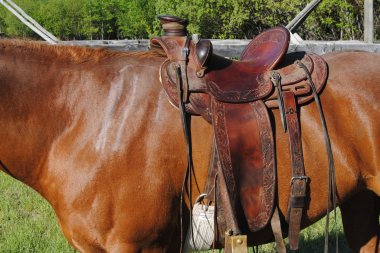
Having the tree in this position means the front of the skirts of the saddle, which extend forward of the front bar tip, will sit just a bit over/on the shoulders of the horse. This is why it is important that the skirts be blocked properly.
So what is blocking?
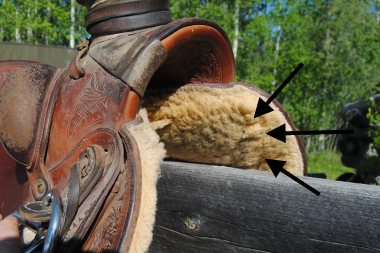 |
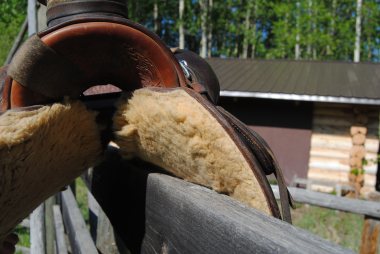 |
| The shaping of the leather of the skirt around the front bar tip is seen even through the sheepskin. | The skirts follow the shape of the front bar pad and front bar tip, curving away from the shoulder of the horse. |
Blocking is done by wetting the skirts and then forming them to the tree so they follow and continue the shape of the relief that is built into the bar edges and tips. Well blocked skirts will curve out from the shoulder blade, allowing free movement. Unblocked or poorly blocked skirts will go straight forward, digging into the muscle over the shoulder, causing pressure and possibly muscle damage and also affecting shoulder movement. They may also hold the front of the tree up so the front bar pad can't sit down on the horse the way it should. (Note: This is why it is a bad practice to set a saddle down on its front. Over time, the skirts will curl under and can affect the shoulders of the horse. If you have to put your saddle on the ground, laying it down on its side does the least damage over time.)
What about rigging position?
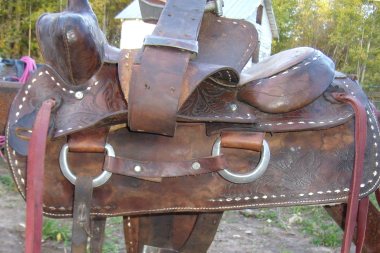 |
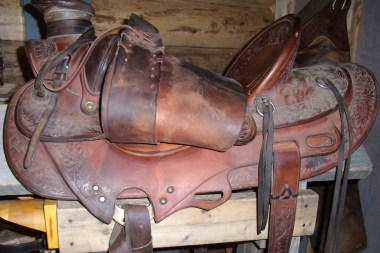 |
| Full rigging position, below the fork | Three quarter rigging position, back of the fork |
The idea that you need to put the rigging forward on the saddle so it hangs vertical in the "girth groove" of the horse or it will pull the saddle out of position is a fallacy. The position of the saddle on the horse is determined by the shape of the tree matching the shape of the horse, not the rigging position or cinch placement.
An example
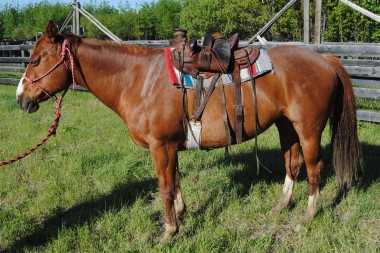 |
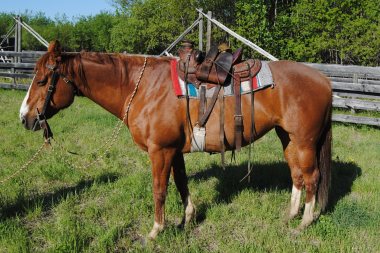 |
| Before riding, bar tip behind shoulder blade, skirts just over shoulder blade, blanket over shoulder blade, latigo and cinch angled forward. Note, the latigo carrier is behind the rigging plate on this saddle. The tail of the latigo puts no pressure on the cinch. | After fifteen minutes of walking and trotting, the cinch, while still angled forward, has moved back a bit, making it slightly more vertical. However, the saddle hasn't moved on the horse's back, despite the constantly angled cinch. |
The cinch will move to the narrowest part of the chest (unless held away from it by something like a center fire rigging position). But an angled latigo and cinch will not pull the saddle out of position if the tree fits. It is only if the tree really doesn't fit the horse or there is excess padding which negates the fit of the tree on the horse that the rigging position can have an effect on saddle position. Rod has used his 3/4 rigged saddle (pictured above) on many different horses over the past almost 25 years. The only time the saddle has moved forward was on a couple really wide, round backed horses it was too narrow for. On one "interesting" backed horse he used a lot, he actually needed a breast collar to keep it forward as it tended to slide back on that horse, even with the latigo angled forward.
It may also appear that a latigo and cinch that is angled forward would cause the saddle to put excess pressure on the back of the shoulder blades, while a saddle with a full rigging position (which is most likely to have a vertical cinch) would be least likely to affect the shoulders. However, this is backwards from what has been shown by pressure testing (unpublished data) to happen in real life. The more forward a rigging is set, the more it pulls down on the front of the tree. The farther back it is set, the more it can pull down more evenly on the whole tree. Of course, rigging design and construction has a large effect on how and where the rigging pulls down on the tree, but practically, a rigging set below the fork will pull down almost exclusively on the front of the bars. Therefore, a forward rigging position can actually cause pressure points at the back of the shoulder blades because it pulls the saddle down tightly at the front and so it doesn't give the shoulder blades enough room to slip underneath the front bar tips so they "bang against the wall". The same saddle with the rigging moved back could allow free shoulder movement. A rigging that is set farther back will probably end up with a latigo that is angled forward, but it won't pull the saddle forward and it will free up the shoulders more than a forward set rigging.
So how do I determine breast collar adjustment?
There are a lot of working cowboys with good fitting saddles that ride and rope some pretty big animals without breast collars and the saddles stay put. But if you must use a breast collar, this is the best way to adjust it.
Step one - Take it off.
Step two - Ride the horse. If you have a brand new saddle you will want to put at least 10 hours, preferably more, into it before you put on the breast collar to allow the sheepskin to start packing down and the leather to start breaking in a little.
Step three - Connect the breast collar so it is not tight where the saddle ends up. This is where the saddle fits, and the breast collar is only there to stop it being pulled out of that position by strong forces.
Step four - Check to make sure that the breast collar is not going over the point of the shoulder where, as the leg moves, it will put pressure on the saddle and pull it forward.
Step five - Walk beside your horse and watch to see if and how tight the breast collar becomes with movement. Remember that you don't want it to pull the saddle forward, and that there will be more pressure on it as the horse extends more at faster gaits, so you really don't want pressure on it at a walk. It is there to keep the saddle from being pulled back - not to pull it forward.
The Bare Basics Summarized
1.) Saddle position is determined by the tree, ending up where shape of the tree matches the shape of the horse.
2.) Western saddle trees are made to sit right behind the shoulder blade, which puts the skirts just over the back of the shoulder.
3.) If the tree fits at all, the saddle will move to the correct position unless you keep it out of position with a breast collar, crupper or britching.
4.) Rigging position does not determine or change saddle position unless the tree doesn't fit the horse or over padding causes the tree to no longer match the shape of the horse.
5.) Rigging position will not move a good fitting tree out of position.
6.) Forward rigging positions can impede shoulder movement.
7.) The skirts need to be well blocked to follow the relief built into the bars so they don't interfere with the shoulder blade.
Click HERE for a video with pressure mat data that demonstrates the Proper Position of a Western Saddle.
For an organized list of all our blog posts on saddle fit, and previews of our Western Saddle Fit videos, click on the links to go to westernsaddlefit.com!
